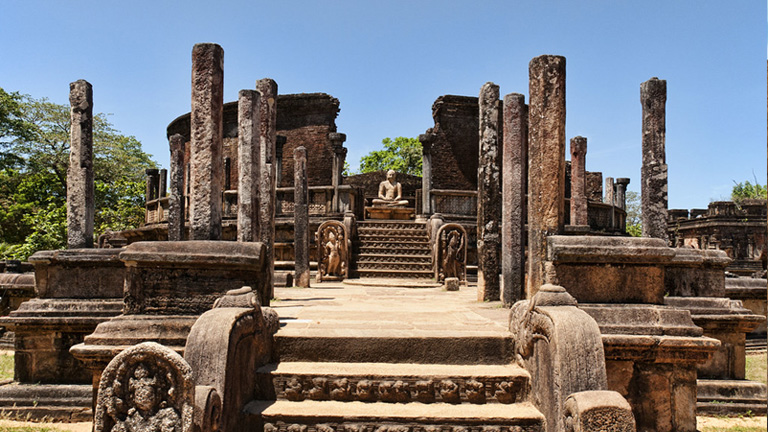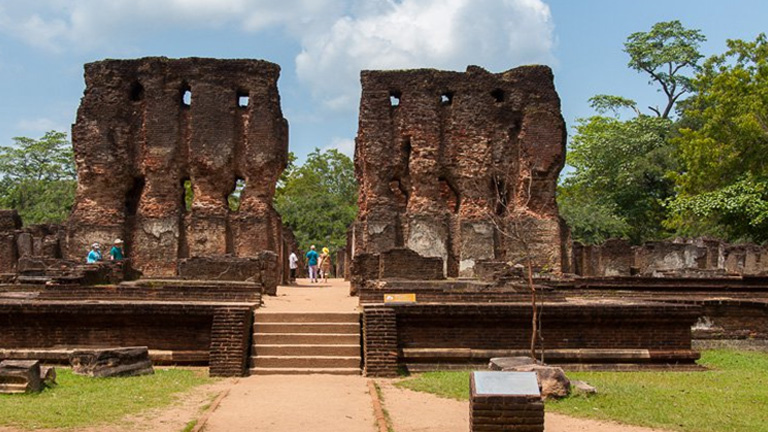Polonnaruwa
This medieval capital of Sri Lanka (11th & 12th Century) rose to fame after the decline of Anuradhapura. The city in its day was fortified with three concentric walls, beautiful with parks and gardens and sanctified with many shrines. Polonnaruwa shows the interesting blend of influence of the South Indian Hindu culture on the Sinhala Buddhist art and architecture in the scattered shrines and monuments still venerated by the devotees.
Places to visit
Gal Vihara
Gal Vihara
This is a group of beautiful Buddha images that probably marks the high point of Sinhalese rock carving. The Gal Vihara consists of four separate statues, all cut from one long slab of granite. The consummate skill with which the expressions of peace, serenity and strength have been carved out of solid rock is simply breathtaking. At one time, each of these statues was enshrined within a separate enclosure. The Standing Buddha is 7m tall. The reclining Buddha depictsing entering Parinirvana (nirvana-after-death) is 14m long. Notice the subtle depression in the pillow under the head and the lotus symbols on the pillow end and on the soles of Buddha’s feet. The other two images are both of the seated Buddha. The carvings make superb use of the natural marbling in the rock.
Watadaege (Circular Relic House)
Watadaege (Circular Relic House)

The Polonnaruwa Vatadage is among the most impressive protective buildings, or vatadage in Sri Lanka. The structure has brick outer walls surrounding a pair of large stone platforms of stone with a network of pillars surrounding them. The large vatadage is made of three concentric circles. There are four Buddha statues and staircases facing the four cardinal directions. They are each white as they sit in meditation on their platforms, backing the little Stupa in the center.
Lankatilaka Temple
Lankatilaka Temple

One of the most evocative structures in Polonnaruwa, the Lankatilaka temple was built by Parakramabahu I and later restored by Vijayabahu IV. This massive Gedige (stone Buddhist temple with corbelled roof and thick walls) has 17m-high walls, although the roof has collapsed. The cathedral-like aisle leads to a huge standing (headless) Buddha. Offerings of incense, and the structure’s columns and arches, add to the distinctly devotional atmosphere. The upper walls, decorated with bas-reliefs, show typical Polonnaruwa structures in their original state.
Royal Palace
Royal Palace

The first group of ruins you meet after entering the ground of the Ancient City is the Royal Palace Group. This group of buildings dates from the period of King Parakramabahu I (1153 – 1186). The King`s Royal Palace is a massive structure, measuring 31 m by 13 m, once including 50 rooms supported by 30 columns. Even today it is quite an impressive building, but it had been seven floors tall with 3 m thick walls, as the archaeologists claim it.
Parakrama Samudraya
Parakrama Samudraya

This is one of the largest manmade inland lakes in the world. It is called the ‘Sea of Parakrama’ owing to waves that play on its surface due to its immense size. Built by Parakramabahu the Great in 12th Century A.D. it is a unique irrigation complex which waters the city as well as the surrounding plains even today. The embankment rises to an average height of 12m and stretches over its entire length of 13.7 km. An evening stroll alongside the bank could provide magnificent views of sun setting over the lake.